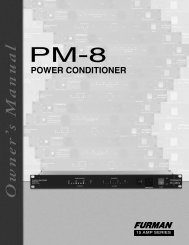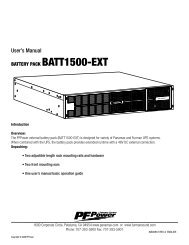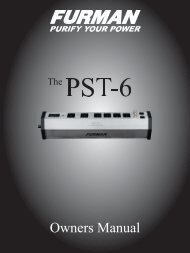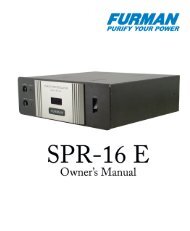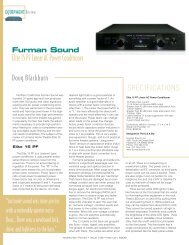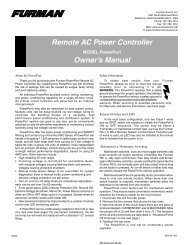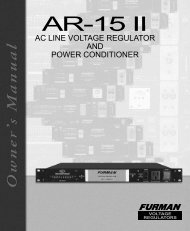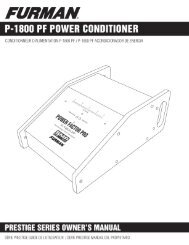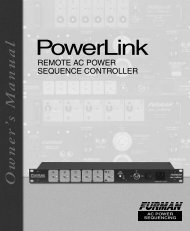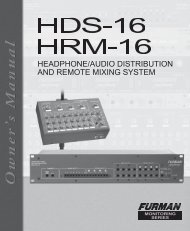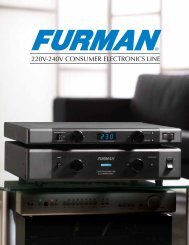manual - Furman Sound
manual - Furman Sound
manual - Furman Sound
- No tags were found...
Create successful ePaper yourself
Turn your PDF publications into a flip-book with our unique Google optimized e-Paper software.
AR-20 II Voltage Regulator / power conditionerVoltage Regulators are not sensitive to smallerrors in line frequency, making them ideal foruse with generators.Maximum and Minimum LoadThe AR-20 II can handle loads totalling up to20 amperes as long as the input voltage isequal to or above 124 volts. For voltages belowthat level, its capacity must be derated at approximately10 amperes per volt. As a practicalmatter, to cope successfully with worst casebrownout conditions, you should plan your totalload so that it does not exceed 16.5 amps, or1980 watts. Please note that this refers to theaggregate power requirement of all equipmentplugged into the Voltage Regulator, not to eachindividual item.NOTE: While there is no minimum load requirementfor the AR-20 II you may experience anaudible mechanical hum coming directly from theunit when the POWER switch is on with nothingplugged in. This effect will sometimes disappearas soon as you plug in any equipment drawing 40to 50 watts total.DefinitionsVOLTAGE REGULATION: The AC line voltageis a number indicating the nominal electricalpotential that has been adopted in a regionfor powering electrical equipment of all kinds.In most of North America it is 117 volts AC; inJapan, 100 volts; and in many other countries220, 230, or 240 volts. The actual voltage canfall below or rise above this nominal level dueto brownouts, power cutbacks, use of substandardwiring, and other causes. These deviationscan cause poor performance or a malfunction.A regulator is a device which, throughuse of a transformer, corrects the voltagedeviation by stepping it up or down so that it isas close as possible to the nominal level.SPIKE: A pulse of energy on the power line.Spikes can have voltages as high as 6000volts. Though they are usually of very short duration,the energy they contain can be considerable,enough to damage sensitive solid-statecomponents in audio and computer equipment.Spikes can also foul switch contacts and degradewiring insulation. They are an unavoidablecomponent of electric power. They arecaused unpredictably by electric motors switchingon or off (on the premises or outside), utilitycompany maintenance operations, nearbylightning strikes, and other factors. Spikes (alsocalled surges or transients) are absorbed byspecial components called MOV’s in the ARseriesto provide safe voltage levels to protectyour equipment.RFI/EMI INTERFERENCE: Noise from RFI(Radio Frequency Interference) or EMI (ElectroMagnetic Interference) involves lower voltagesand less energy than is found in spikes, but it iscontinuous rather than transient in nature. It isnot likely to cause physical damage, but it cancertainly be annoying, producing static in audiocircuits, “snow” on video screens, or garbleddata in computers. Noise can be introduced intoAC lines by nearby radio transmitters, certainkinds of lighting, electric motors, and others.Because noise occurs at higher frequenciesthan the 50 or 60 Hz AC line, it can be effectivelyreduced through use of low-pass filtering.Three-Year Limited Warranty<strong>Furman</strong> <strong>Sound</strong>, LLC., having its principal placeof business at 1690 Corporate Circle, Petaluma,CA 94954 (“Manufacturer”) warrants its AR-20 II(the “Product”) as follows:5



